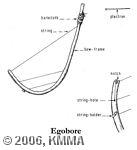
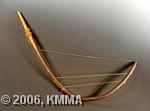

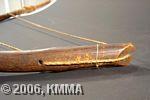

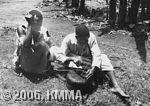
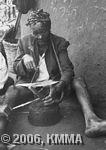

Other name: nnanga.
The ekidongo is a musical bow with several strings. The string bearer or bow consists of a flexible branch that has been dried for a long time. Holes are burnt into the bow with a heated point and one single long string made of plant fibre is pulled through the string bearer to string the entire instrument. The string is held into place at one end by a wooden peg that sits crossways across the bow (the same system as for the enanga) and bark and cotton are wound around the other end. This gives the ekidongo three strings, two shorter parallel strings on the inner side of the string bearer and one longer one attached to the outer ends of the bow. The bow is not symmetrical but has one short arm and one longer one.
In order to strengthen the sound the player rests the ekidongo on a separate sound box whilst he is playing; this resonator is usually a utensil such as a cooking pot. The instrument is put onto the cooking pot in an upright position, leaning against the player's left shoulder. The string is held close to the player's face because he needs to be able to damp the string with his chin. The player can damp the string with his chin in two places, which allows him to produce a different pitch when he plays. The two shorter strings are always open. The ekidongo has five possible notes in total. The player plucks the two shorter strings with the thumb of his right hand and plays the upper two strings with a plectrum - a hard wooden peg measuring 10 cm in length - with his left hand. The middle string is played with both hands. The ekidongo player sits on the ground with the musical bow in front of him. Next to him is a second person who provides a rhythmic beat by striking the edge of the cooking pot with a slightly-bent stick.
The ekidongo is never combined with other instruments and is only played by men. The performer always combines singing with instrumental play. The lyrics of the songs relate important events in the village or extol eminent persons.
for more information see also: VAN THIEL, Paul, "Multi-Tribal Music of Ankole. An ethnomusicological study including a glossary of musical terms." Edited by the Royal Museum for Central Africa, Annales, Sciences Humaines, nr 91, 1977, 234 pp.
© KMMA/Paul VAN THIEL